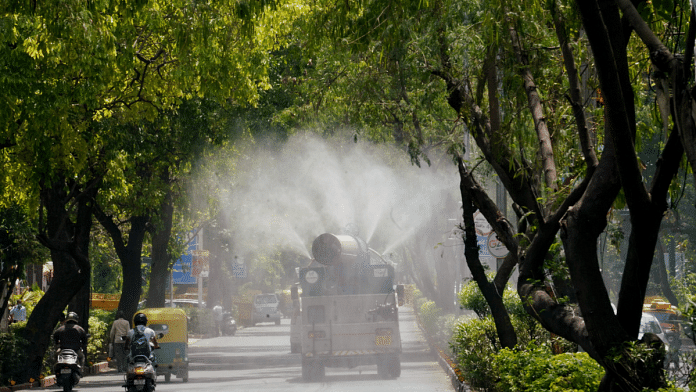Bengaluru: As Delhi struggles with severe air pollution, the government is considering a new solution — cloud seeding. This technique involves spraying particles into the clouds in an attempt to induce rain and wash away the pollutants.
For this purpose, environment minister Gopal Rai on 8 November met with a team from IIT Kanpur to discuss the details of such a project, which could be implemented later this month.
The Delhi government has reportedly sought several meetings with teams from IIT Kanpur teams to learn more about cloud seeding (or artificial rain) and how it can help reduce the pollution levels by using the institute’s own planes, which can release particles.
However, the IIT officials have reportedly warned that the technique would only offer temporary relief.
Cloud seeding has been around for over a hundred years, and some countries have used it in attempts to prevent droughts and floods, and also during wars. However, its scientific validity and environmental impact are still debated.
With Delhi’s Air Quality Index (AQI) remaining in the severe category (408) at 7am Friday — a slight improvement from 437 at 4pm on Thursday — can cloud seeding help the capital breathe easier? ThePrint explains.
Modifying the weather: How does it work?
As climate change impacts worsen, weather modification technologies have gained attention in some quarters. Cloud seeding is one of these technologies that — as well as inducing rain — aims to prevent very heavy rainfall.
The idea is that when certain particles are discharged into the air, they act as a nucleus around which water condenses, forming a droplet. As these droplets accumulate and become heavy, rainfall is triggered.
This is said to have have two benefits: creating rain for purposes such as easing the pollution situation temporarily, or removing moisture from the clouds to avoid a more severe downpour later. It is also used to induce snowfall.
Cloud-seeding chemicals can be dispersed into the atmosphere by aircraft as well as devices on the ground.
However, its effect and effectiveness in inducing rainfall is highly debated, with no definitive data from numerous experiments.
Countries like the US, China, Israel, UAE, Japan, Germany, and Switzerland have performed experiments through various methods, including electric charge emissions and infrared laser pulses. However, while some have reported a light to moderate increase in precipitation, the scientific data available today suggests that the efficiency is very low or negligible.
There have been no statistically significant results in any experiments to justify investing in this technology yet, although some claim that there have been local effects. The extent of effect water droplets have on cleaning the atmosphere is also unknown.
How rain drags down pollutants
The Delhi government is attempting to use cloud seeding and rainfall to help clear pollution from the atmosphere. Some experiments have shown that rain indeed can help clear the air by attracting pollutant particles to water droplets, and washing them down to the surface.
Studies have revealed that the smaller the droplets used, the more the particles they can capture. This process is called coagulation, and for this, water is sprayed through a high-pressure nozzle in an aerosolised manner as a very fine spray.
However, the interactions between particles and droplets are not well understood — it is unclear what size of water droplets coagulate with which kind of pollutants, and how efficiently fine droplets can wash away particles from the atmosphere.
Experiments that have yielded measurable data have come from controlled settings, such as a glass chamber.
Moreover, the relationship between the extent of improvement or worsening of the problem and the level of pollutants in the air is also unclear.
This is because water droplets drag polluting particles down to the soil and lower altitudes, instead of letting them disperse in the upper atmosphere.
In turn, more particulate matter comes closer to the breathing heights of young children and surfaces if not washed away as surface runoff.
Also Read: How green are green crackers & why they’re still trumped by traditional fireworks despite SC ban
Is cloud seeding effective?
The concept of cloud seeding is not new and it has been attempted for more than a hundred years.
One of the famous accounts is that of the American “rainmaker” Charles Hatfield, who in 1915, promised rain and apparently made it happen. He and other “pluviculturists” or the pseudo-scientists who performed rainmaking, used to brew chemical concoctions and release their fumes and smoke into the clouds.
In his most famous public attempt that year, Hatfield constructed a 20-foot-tall tower and brewed a mixture at the top on shallow iron pans. Onlookers reported seeing the pans aflame and heavy, noxious, smelly smoke rising to the sky.
However, despite his seeming success, extreme rains caused more damage to the San Diego township, and the onset of the Great Depression and newly built dams improved water management, ending his business. Such “rainmakers” have been dismissed as hacks, and there is still no data on how to make it rain.
Just like Hatfield’s mixture, today’s cloud-seeding particles are also toxic. Particles sprayed into the cloud for seeding are typically silver iodide, potassium iodide, liquid propane, salts, and dry ice.
Silver iodide has been known to cause harm and disability to mammals upon chronic exposure, but the amounts used for seeding purposes are thought to be unlikely to cause these effects.
The case is similar for surface runoff, which has not been proved to be measurable for seeding material. Its local effects have been contentious, and countries like the US have also used cloud seeding operations in the Vietnam War and the Cold War.
Even when used in Delhi, the data and effects are unclear. If anti-smog guns, which spray aerosolised water, are placed near air quality sensors, lower pollution readings are obtained, which do not necessarily reflect a location’s true AQI.
(Edited by Richa Mishra)
Also Read: Air pollution linked to surging Type 2 diabetes cases, finds 7-yr study of Delhi & Chennai residents



